This week the discussion of the Rabbis Freedman is about the Golden Calf and its aftermath.
You can subscribe directly to the YouTube channel here: https://www.youtube.com/channel/UCnamNZsuUWMC-oBbV4XB7Hg
This week the discussion of the Rabbis Freedman is about the Golden Calf and its aftermath.
You can subscribe directly to the YouTube channel here: https://www.youtube.com/channel/UCnamNZsuUWMC-oBbV4XB7Hg
A new video series featuring, Rabbi Freedman, Rabbi Freedman, and Rabbi Freedman! You can subscribe directly to the YouTube channel here: https://www.youtube.com/channel/UCnamNZsuUWMC-oBbV4XB7Hg
This week’s discussion is about the skills that the Jews needed to build the Tabernacle – the portable Temple that they carried with them throughout their 40 year journey in the desert.
Click here for a printable PDF of this article.
It has been one year and one month since the exodus from Egypt. The Jewish people, divided by tribe into clusters 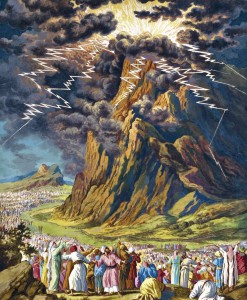 around a central point, have just completed erecting the Tabernacle as the nucleus of the encampment. Each tribe is now assigned a flag that highlights that tribe’s unique abilities and strengths.
around a central point, have just completed erecting the Tabernacle as the nucleus of the encampment. Each tribe is now assigned a flag that highlights that tribe’s unique abilities and strengths.
The timing of the designation of the flags begs a question. Why did God wait until now to instruct the various tribes to carry flags? The Jews had been separated and organized by tribe as soon as they left Egypt, over a year ago. It would seem fitting for them to display their tribal flags from the very start! Continue reading Parshat Bamidbar | Shavuot – Unity Despite Individuality
Click here for a printable PDF of this article.
In this week’s parshah, we discover what we will receive if we fulfill t he mitzvot properly and the consequences if we do not. The Torah delineates all of the blessings that will be showered down upon us for following the directions of God and all of the terrible curses that await us if we don’t fulfill our responsibilities.
he mitzvot properly and the consequences if we do not. The Torah delineates all of the blessings that will be showered down upon us for following the directions of God and all of the terrible curses that await us if we don’t fulfill our responsibilities.
The Torah uses an interesting terminology when it introduces the potential blessings. It states, “Im bechukotai teleichu” – if you travel with my laws, then you will receive these blessings. Why does the Torah use such an unusual phrase to express the idea of fulfilling the laws of God? Why doesn’t it simply say, “if you follow my laws?” What message is the Torah trying to convey? Continue reading Parshat Bechukotai – Traveling with the Torah
Click here to download a printable PDF version of this article.
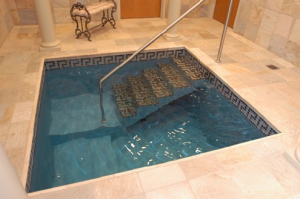 In the beginning of this week’s Parshah, the Torah states that after a woman gives birth she becomes tamei, ritually impure. If she gave birth to a son, she waits for seven days, at which point she immerses in a mikvah, a ritual pool. Thirty-three days later – a total of forty days after the birth – she brings an offering in the Temple and fully regains her spiritually-pure status. If a woman gives birth to a baby girl, however, the first period lasts for fourteen days and the second period lasts for sixty-six – a total of eighty days after the birth. One might think that there is something ‘wrong’ with an infant girl that causes her mother to become ritually impure for forty days longer than a baby boy would! Continue reading Parshat Tazriah – Partnering with the Creator
In the beginning of this week’s Parshah, the Torah states that after a woman gives birth she becomes tamei, ritually impure. If she gave birth to a son, she waits for seven days, at which point she immerses in a mikvah, a ritual pool. Thirty-three days later – a total of forty days after the birth – she brings an offering in the Temple and fully regains her spiritually-pure status. If a woman gives birth to a baby girl, however, the first period lasts for fourteen days and the second period lasts for sixty-six – a total of eighty days after the birth. One might think that there is something ‘wrong’ with an infant girl that causes her mother to become ritually impure for forty days longer than a baby boy would! Continue reading Parshat Tazriah – Partnering with the Creator
Click here for a printable PDF of this article.
Matzah clearly plays a central role in the Passover holiday. On Seder night, there is a specific mitzvah to eat matzah. In addition, the Torah prohibits the consumption of 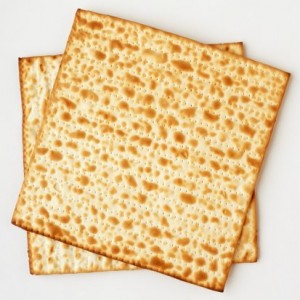 chametz, the antithesis of matzah, for all eight days of Passover. What do matzah and chametz symbolize, and why are they so central to our celebration of Passover?
chametz, the antithesis of matzah, for all eight days of Passover. What do matzah and chametz symbolize, and why are they so central to our celebration of Passover?
Rabbi Samson Raphael Hirsch (1808 – 1888; Frankfurt, Germany), explains that as we know, matzah is bread that is made from dough that was not given time to rise. This type of bread would generally be eaten by one who is pressed for time. As a matter of fact, the Talmud nicknames matzah, lechem oni – poor man’s bread. A poor man is always in a flurry trying to survive and therefore has no time to allow his dough to rise. Throughout our slavery in Egypt, our Egyptian masters did not allow us the time needed for our dough to rise. Hence, we usually ended up eating matzah. Upon our long awaited departure from Egypt, we still ate matzah, as the Egyptians were driving us out, again not giving our dough time to rise.[1] Matzah, therefore, symbolizes servitude. Chametz, on the other hand, is the bread of one who is his own master. He can allot however much time he desires to make sure his bread rises appropriately. Chametz symbolizes independence. Continue reading Passover – Matzah: Celebrating our Dependence on God
Click here to download a printable PDF of this article.
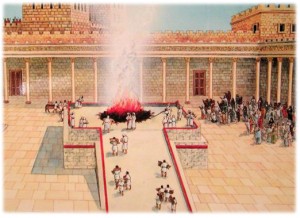 During the days of the ancient Jewish kingdom in Israel, the focal point of the nation was the Temple. The Temple was a place where the glory of God was revealed on a daily basis; our Rabbis teach us that ten ongoing miracles took place there. One of those miracles was that regardless of how much it may have rained, the rain was never successful in extinguishing the fire that was always present on the altar.
During the days of the ancient Jewish kingdom in Israel, the focal point of the nation was the Temple. The Temple was a place where the glory of God was revealed on a daily basis; our Rabbis teach us that ten ongoing miracles took place there. One of those miracles was that regardless of how much it may have rained, the rain was never successful in extinguishing the fire that was always present on the altar.
Rabbi Chaim Ickovits (Volozhin, 1749 –1821) points out that this miracle is puzzling, since God is omnipotent. Why would He choose to cause rain to fall on the altar and then prevent the rain from extinguishing the fire, instead of not allowing it to rain in the area of the altar in the first place? Continue reading Parshat Tzav – The Persistence of the Altar’s Fire
Click here to download a printable PDF of this article.
One of the karbanot, offerings, brought in the Temple was the Korban Todah – the Thanksgiving Offering. If a person was in a dangerous situation and managed to survive, he would travel to the Temple in Jerusalem and bring such an offering. Nowadays, when one survives a situation in which his life was in danger, he or she re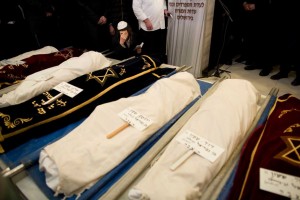 cites a special blessing called Birchat HaGomel in place of the Thanksgiving Offering.
cites a special blessing called Birchat HaGomel in place of the Thanksgiving Offering.
We have all heard of the tragedy this past week in Brooklyn, in which a fire broke out in the middle of the night, leaving seven children from the Sassoon family dead and their mother and the eighth child in critical condition. It is beyond belief and the pain is tremendous. Losing one child is a colossal tragedy in and of itself; losing seven in one shot? Unimaginable. Continue reading Parshat Tzav – In the Wake of the Brooklyn Tragedy: Hugging our Children
Click here for a printable PDF of this article.
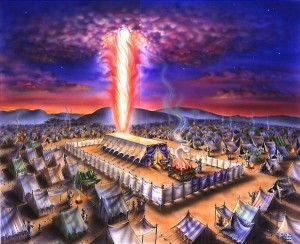 We have spent the past few weeks following the conversation between God and Moses as to how to build the Tabernacle, its vessels, and the priestly clothing. This week, the Torah tells us that Moses appointed Betzalel to lead the building project. Throughout the parshah, as the Torah describes the actual construction of the Tabernacle, it continually states, “such and such was done as God commanded Moses.” Why, while discussing the topic of the Tabernacle, does the Torah stress that everything was done, “as God commanded Moses,” more than any other part of the Torah? Continue reading Parshat Pekudei – Our Moral Compass
We have spent the past few weeks following the conversation between God and Moses as to how to build the Tabernacle, its vessels, and the priestly clothing. This week, the Torah tells us that Moses appointed Betzalel to lead the building project. Throughout the parshah, as the Torah describes the actual construction of the Tabernacle, it continually states, “such and such was done as God commanded Moses.” Why, while discussing the topic of the Tabernacle, does the Torah stress that everything was done, “as God commanded Moses,” more than any other part of the Torah? Continue reading Parshat Pekudei – Our Moral Compass
Click here to download a printable PDF of this article.
In reading through the verses describing the aron, the Ark, we find a running theme of duality. The Ark was comprised of a box made from cedar wood, sandwiched between and inner and outer gold box –  two layers of gold. There were two cherubs attached to the cover of the Ark. There were two tablets placed within the Ark. What is the meaning of this theme?
two layers of gold. There were two cherubs attached to the cover of the Ark. There were two tablets placed within the Ark. What is the meaning of this theme?
Throughout Jewish writings, the Ark clearly is symbolic of the Torah. The lesson of the duality is that Torah observance requires joining with others. Judaism is not meant to be practiced in isolation. We are supposed to be part of a community. Continue reading Parshat Terumah – The Duality of the Ark